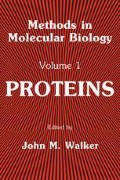Abstract
Thin-layer chromatography and electrophoresis, either separately or in combination, provide a simple, high resolution technique for producing peptide maps. Recently, thin-layer methods have tended to be increasingly overshadowed by the development of high performance liquid chromatography (HPLC). Although thin-layer methods are generally not as sensitive as HPLC (requiring milli- or microgram amounts of protein instead of the nanogram or less quantities used in HPLC), they are still preferred for many applications. Thin-layer peptide mapping not only has the advantage of being relatively inexpensive, but it is also a very simple technique and it is often possible to analyze a large number of different samples in a single experiment. In addition, a number of different stains can be used for the detection of specific amino acids and these considerably increase the value of this method.
Access this chapter
Tax calculation will be finalised at checkout
Purchases are for personal use only
References
Powers, D. A., Fishbein, J. C., and Place, A. R. (1983). Thin-layer peptide mapping with sequencing at the nanomole level. In Methods in Enzymology 91, Hirs, C. H. W. and Timasheft, S. N. eds. pp. 466–486. Academic Press, New York.
Heilman, J., Barrollier, J., and Watzke, E. (1957) Beitrag zur aminosaurebestimmung auf papierchromatogrammen. Hoppe-Seylers Zeit. 309, 219–220.
Felix, A. M., and Jimenez, M. H. (1974) Usage of fluorescamine as a spray reagent for thin-layer chromatography. J. Chromatogr. 89, 361–364.
Gardner, W. S., and Miller III, W. H. (1976) Reverse-phase liquid chromatographic analysis of amino acids after reaction with o-pathaladehyde. Anal. Biochem. 101, 61–65.
Bennett, J. C. (1967) Paper chromatography and electrophoresis; special procedure for peptide maps. In Methods in Enzymology, XI, Enzyme structure, pp. 330–339. (Hirs, C. H. W. ed.) Academic Press, New York.
Yamada, S., and Itano, H. A. (1966) Phenanthrenequinone as an analytical reagent for arginine and other monosubstituted guanidines. Biochim. Biophys. Acta 130, 538–540.
Brown, J. R., and Hartley B. S. (1966) Location of disulphide bridges by diagonal paper electrophoresis. The disulphide bridges of bovine chymotrypsinogen A. Biochem. J. 101, 214–228.
Crestfield, A. M., Moore, S., and Stein, W. H. (1963) The preparation and enzymatic hydrolysis of reduced and S-carboxymethlated proteins. J. Biol. Chem. 238, 622–627.
Dayhoff, M. O., Hunt, L. T., and Hurst-Calderone, S. (1978) Atlas of Protein Sequence and Structure 5,Supplement 3, pp. 363–373 (ed. Dayhoff, M. O.) National Biomedical Research Foundation, Washington, DC.
Croft, L. R. (1980) Handbook of Protein Sequence Analysis. 2nd edition, Wiley, New York.
Walker, J. M., Gooderham, K., Hastings, J. R. B., Mayes, E., and Johns, E. W. (1980) The primary structures of non-histone chromosomal proteins HMG 1 and 2. FEBS Lett. 122, 264–270.
Author information
Authors and Affiliations
Editor information
Editors and Affiliations
Rights and permissions
Copyright information
© 1984 Humana Press
About this protocol
Cite this protocol
Gooderham, K. (1984). Peptide Mapping by Thin-Layer Chromatography and High Voltage Electrophoresis. In: Walker, J.M. (eds) Proteins. Methods in Molecular Biology™, vol 1. Humana Press. https://doi.org/10.1385/0-89603-062-8:179
Download citation
DOI: https://doi.org/10.1385/0-89603-062-8:179
Publisher Name: Humana Press
Print ISBN: 978-0-89603-062-6
Online ISBN: 978-1-59259-488-7
eBook Packages: Springer Protocols

